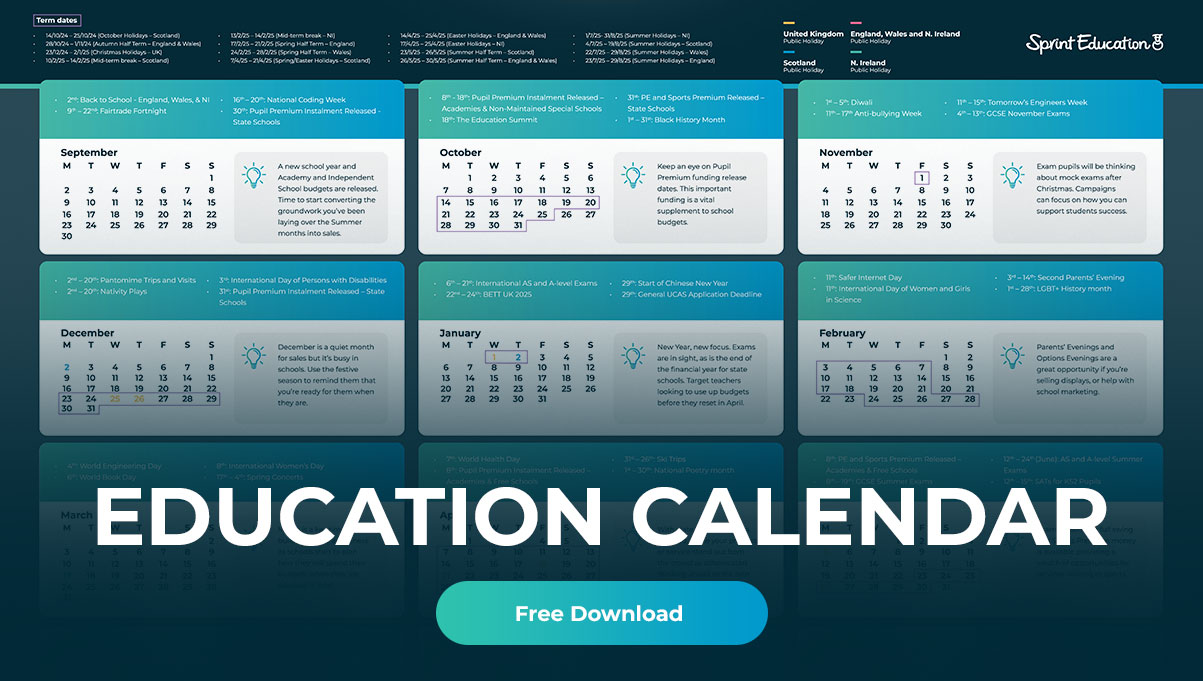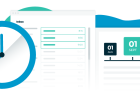Turn timing your education emails into an artform!
Turn timing your education emails into an artform!
Gain exclusive insights into the timing of your education marketing emails to engage with your target audience and increase your sales potential.
Gain exclusive insights into the timing of your education marketing emails to engage with your target audience and increase your sales potential.
“Time is an illusion, timing is an art.” ― Stefan Emunds
It’s a wet Wednesday morning in December. You’re in charge of your school Nativity play the next day and gearing up for the dress rehearsal. As you do your routine morning check-in on your school pigeon hole you see a letter from Company A suggesting songs that you could use in your upcoming Nativity. You chuckle incredulously and pop it in the recycling.
It’s a wet Wednesday morning in September. You’re in charge of your school Nativity play in a couple of months and looking for ideas of a theme. As you do your routine morning check-in on your emails you see one from Company B suggesting songs that you could use for your Nativity. You flag the email, ready to read it more carefully later in the day.
I’m sure you’ve already made your decision of which company got their timing right, and which one didn’t.
Timing is Everything
The songs Company A had to offer could have been the very best Nativity songs ever to grace the stage of a Primary School hall, but that’s no use to anyone if the people selecting them don’t know about them until the day before the show. This may seem an obvious statement to make. It’s almost like saying ‘what good is emailing about a new revision guide for GCSE ‘whichever-subject’ in May?’ or ‘let’s start a conversation about your new school gym’ in late July, just as schools are getting ready for the long Summer break.
This is where we come in.
In March, we released our third State of Selling to Schools Report. With two former teachers (myself and my colleague, Lance) asking the questions and then analysing the responses, this is the most in-depth report yet and you know what? So much of what we found in the report hinges on good timing.
We asked about when schools make their biggest purchasing decisions. We asked when they renew subscriptions or rolling contracts. We asked the most convenient time for education suppliers to connect with educators. And we asked how much notice should be given by an education supplier for a range of products and services.
What I’m going to do here is break these down into the two main factors you need to consider when devising the timing of your strategy:
Notice periods and Email timing
I’m not going to patronise here and give definitions. What I will do is to offer some insights into why getting the timing of your notice period right will make all the difference when engaging with your target audience.
Let’s go back to our Nativity play. Company A messed up their notice period by trying to get a late sale when the teacher in charge of the play had passed their point of no return. As a music teacher myself, I know that it takes several weeks to teach young children a new song. I would certainly have started working on that song with them from the start of the new half term in late October/early November, knowing that I would be lucky if I had fifteen to twenty minutes of meaningful practice with them each week. I would have liaised with the class teacher to help support the learning of the song at appropriate times of day for them. I may even have created backing tracks to further support the children in their learning. All in all, it’s taken six weeks to two months to get that song from ‘chosen’ to ‘performed’.
Let’s look at a different example. You’ve got a piece of school management software that is going to revolutionise your response to school absence. This is certainly an issue that has been ever-present in education news since the return to full time schooling following the pandemic.
I’m going to check in on the survey results at this point. We know that 30.9% of educators see EdTech as beneficial for addressing school attendance. We also know that 30.7% of contract renewals take place in September. These two factors will help us to plan the timing of that first contact to schools. This is because we know: a. that there is a feeling that EdTech can support improving attendance in schools; and b. if we want to get that renewal sale to go through in September as planned, we need to lay some groundwork over the summer months to ensure that your target schools know that this is the product for them.
September came top in our survey for the best time to make contract renewals and bigger purchases. As the new academic year gets underway, it’s time for a ‘fresh start’ and a new opportunity to take a different approach to something that perhaps has not been working so well. The EdTech company in question will have hopefully given the school a demo version of the software to trial across June and July in order for the senior leaders at least to get some idea of how it will help. Then when September hits and staff return for the new year inset, those senior leaders have the opportunity to train up the rest of the staff into how to get the most out of the new system.
New systems can frighten teachers. I know this from first hand experience. We get used to one way of working and it often feels like as soon as that system has found its feet, it makes way for something else that’s ‘bigger and better’! So if you, as an EdTech company, can provide some user-friendly CPD to support this new approach, so much the better.
One way that we can help further with your notice period, aside from the expert advice from our Campaigns and Education Teams, is through our Desktop Calendar. Each year we curate an easy access calendar that includes some key dates for the academic year ahead. It tells you when Public Holidays fall in the UK, exam dates, details of funding streams such as Pupil Premium and Sports Premium, and a selection of notable dates or events that relate to the wide variety of sectors that we help to engage with schools.
Going one step further, our Campus clients enjoy access to our Education Insights Calendars. I say one step further: they’re more of a giant leap further. You can tailor the Education Insights Calendars to your specific needs, with full details of regional term dates in the UK, tabs for Wellbeing, Education conventions, Sporting events and over 150 themed days or weeks that could be the selling point you’ve been looking for to get your product into schools. Get in touch to find out more about Campus.
These are all ways to nail down that notice period and become a timing artist.
The second thread is ‘Email timing’
This relates more to when your email is read by educators, more so than when it actually lands in their inbox.
All teachers have a routine for their day. The first thing many teachers will do is open up their laptop to see what emails they’ve received since the previous day. The school my wife works in has a strict ‘no send’ policy after 7pm, so quite often she will have an important email scheduled to send at 8am the following morning so that her colleagues pick it up in good time before the start of the school day.
These emails could be about anything and everything to do with their job: plans for a trip; information regarding a student; booking a computer room; or having to rearrange after something has come up meaning a last minute change of location for that important presentation. The list is endless. When it comes to marketing emails, teachers tend to scan and save them to read during non-contact time, so they can consider them properly.
We know from our survey that 46.8% of teachers check their email more than ten times a day. That’s a lot, but as I said above, that will mostly be dealing with school-related business. However, when you add the frequency of opens to what we already know about email performance, see [‘How our performance stacks up against the rest’] (https://sprint-education.co.uk/learn/statistics) page, it shows that 8am-9am is the best time for email opens. While that remains the case, when an email is opened can differ to a teacher’s preferences on when to engage with its content.
Teachers told us the best time for them to engage with marketing is after school or in their non-contact time. 44.1% of respondents chose after school, while 28.2% chose ‘anytime’ which can realistically be translated as ‘when I find the time’. This illustrates the point that teachers will want to take their time to consider what you have to offer, so it’s more about making it a ‘must-read’ for them to flag and follow up when they get the chance. We can help you with that too: we know all about eye-catching subject lines, captivating copy and stand out calls to action.
There is one other thing to bear in mind. As part of the sales process, particularly when repeat business is on the table, building a relationship with schools is hugely important. They need to see that you can really add value to their teaching environment, processes and ultimately the learning and overall school experience of the children and young people.
This could be through the offer of a free webinar, providing online or onsite training in your solution, or a chance to discuss your solution with them in more detail. Our survey asked how much notice teachers like to have from first contact to delivery, and results weighed heavily in favour of one to three months’ notice. The exception here was the free webinar which had a shorter turnaround of four to six weeks.
A last point. Read the room. Keep an eye on what’s going on in education news so you don’t put your foot in it! As I write this, Ofsted are persona non grata to teachers: every news outlet is reporting the tragic death of Ruth Perry and the pressure inspections heap on school leaders. So steer clear of them for now. Conversely, the England Lionesses have recently had a hand in some sports funding for girls to get more equal access to a wider range of sports, so that could be a success story you can draw on.
Next Steps
You can start perfecting the art of timing by reading the scheduling insights in our free State of Selling to Schools Report 2023. For a big picture view our Desktop Calendar is a handy desktop wallpaper to keep your eye on the key eductional events coming up in the 2023-24 school year.
If you want to be more responsive in your timing and be able to view detailed calendar events for the UK and for Internatioanl markets, alongside the data from our survey, then all this can be accessed via the Intelligence module on our selling-to-schools software Campus.
Get in touch about Campus today, email info@sprint-education.co.uk or call 01684 297374 and speak to our team about when the best time is to sell your product or service to schools.
Tags
Education Marketing
Email
Email Marketing
Emailing Teachers
Emailing Teachers in Schools
Marketing
Marketing Strategy
Similar Articles


The Beginner’s Guide to International Schools Marketing
Understand and sell to the types of education establishments across the globe.

Stay up to date – the year ahead at a glance
Essential dates for every edu-marketeer’s diary.


Expert marketing to schools support and solutions
Expert marketing to schools solutions
Email Head Teachers, Teachers, and Staff Inboxes
Email teachers and staff inboxes
Sell More to UK and Global Schools and Colleges
Sell more to schools and colleges

































